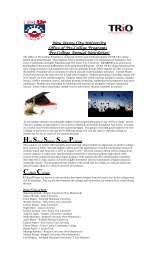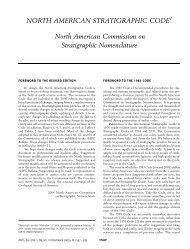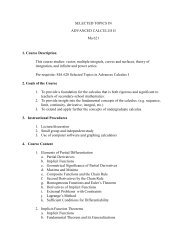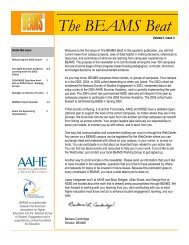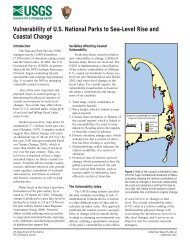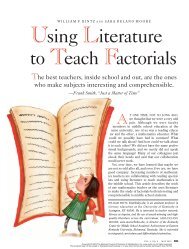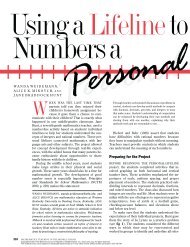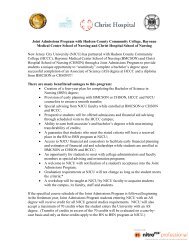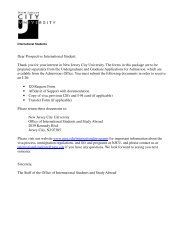DEEP Practice Brief Small Steps Campuses Can Take - NSSE
DEEP Practice Brief Small Steps Campuses Can Take - NSSE
DEEP Practice Brief Small Steps Campuses Can Take - NSSE
Create successful ePaper yourself
Turn your PDF publications into a flip-book with our unique Google optimized e-Paper software.
Promoting Student Success<br />
<strong>Small</strong> <strong>Steps</strong><br />
<strong>Campuses</strong> <strong>Can</strong><br />
<strong>Take</strong><br />
Elaine El Khawas<br />
Occasional Paper #9<br />
Six Conditions that Matter to Student Success<br />
I. “Living” Mission and “Lived” Educational Philosophy<br />
II. Unshakeable Focus on Student Learning<br />
III. Environments Adapted for Educational Enrichment<br />
IV. Clear Pathways to Student Success<br />
V. Improvement-Oriented Ethos<br />
VI. Shared Responsibility for Educational Quality and<br />
Student Success<br />
C olleges and universities can increase the<br />
number of students who graduate by making a<br />
number of small, strategic changes in<br />
institutional policies and practices. Some<br />
schools have done this by focusing on effective<br />
educational practices and empowering faculty,<br />
staff and students to work together in new,<br />
productive ways. Others have improved the<br />
campus climate for learning by carefully<br />
assessing what students are experiencing or by<br />
realigning resources to induce students to<br />
participate in activities associated with<br />
persistence and other desired outcomes of<br />
college. Senior administrators play a key role<br />
in such efforts when they speak plainly and<br />
consistently about the importance of student<br />
success and make decisions congruent with this<br />
priority.<br />
The suggestions offered here are drawn from a<br />
study of 20 diverse four-year colleges and<br />
universities that have higher-than-predicted<br />
graduation rates and, through the National<br />
Survey of Student Engagement (<strong>NSSE</strong>),<br />
demonstrated that they have effective practices<br />
for fostering success among students of<br />
differing abilities and aspirations. These<br />
institutions – called <strong>DEEP</strong> schools here because<br />
they were studied for the project on<br />
Documenting Effective Educational <strong>Practice</strong>s --<br />
clearly communicate that they value high<br />
quality undergraduate teaching and learning,<br />
and provide effective, well-linked academic<br />
and support services. Despite constraints, they<br />
have found ways to create supportive learning<br />
environments, ensuring that students engage<br />
with course content, faculty and peers, inside<br />
and outside the classroom.
<strong>Small</strong> <strong>Steps</strong> <strong>Campuses</strong> <strong>Can</strong> <strong>Take</strong> 2<br />
1. Develop a compelling message, share it<br />
with everyone<br />
The various public presentations that presidents,<br />
provosts, deans and other senior administrators make are<br />
opportunities to underscore the importance of promoting<br />
student success and its value to both students and the<br />
institution. In annual state-of-the-campus reports,<br />
convocations, board meetings and other occasions,<br />
leaders can signal that student success is an objective for<br />
all groups on campus, not just for certain groups or<br />
offices.<br />
At <strong>DEEP</strong> schools, presidents and provosts systematically<br />
encouraged a broad institutional commitment to student<br />
success by conveying a clear message repeated by other<br />
senior campus leaders. Sustained energy, consistent<br />
signals, and purposefulness are needed to surmount<br />
institutional inertia and organizational complexity in<br />
support of student success. Leaders honed their message,<br />
found the most compelling words for their setting, and<br />
then used it again and again. They reinforced it with<br />
examples, special commissions, and systematic studies<br />
focused on the quality of the undergraduate experience.<br />
For example, the dean of arts and<br />
sciences at the University of<br />
Michigan championed new<br />
learning initiatives with help from a<br />
special commission and several<br />
reports over a four-year period. The<br />
University of Kansas provost made<br />
the case for why good teaching<br />
matters at his research intensive<br />
university. Over time, his message<br />
became a widely recognized mantra<br />
cited by campus officials, students<br />
and faculty alike and reinforced by multiple awards made<br />
annually to recognize outstanding teaching. At<br />
California State University, Monterey Bay a faculty<br />
group prepared a “reflective essay” about the role and<br />
nature of academic rigor in their context to underscore<br />
the importance of challenging and supporting their<br />
students, many of whom because of their backgrounds<br />
are not expected to attend—let alone graduate—from<br />
college.<br />
2. Focus on making small changes that can<br />
have big impact<br />
For students, college often resembles a confusing maze<br />
of seemingly unconnected offices, programs, and people.<br />
<strong>Small</strong> adjustments can increase their accessibility and<br />
create a more coherent experience. Karl Weick (1984)<br />
observed that a series of “small wins” is more likely to<br />
have desired effects than a single, complex initiative. A<br />
small win is “…a concrete, complete, implemented<br />
“Students benefit from knowing<br />
that the institution wants them and<br />
others to succeed. Senior<br />
administrators send strong<br />
messages that students matter<br />
when their voices are heard and<br />
respected on important policy<br />
decisions....”<br />
outcome of moderate importance. By itself, one small<br />
win may seem unimportant. A series of wins at small but<br />
significant tasks, however, reveals a pattern that may<br />
attract allies, deter opponents, and lower resistance to<br />
subsequent proposals” (Weick, 1984, p. 43). Ursinus<br />
College clusters all first-year students in one area of<br />
campus housing in order to make it easier for them to talk<br />
with one another about idea and topics introduced in the<br />
Common Intellectual Experience – interdisciplinary<br />
coursework required of all students that features common<br />
readings and specially designed out-of-class activities.<br />
At Longwood University, the vice president for student<br />
affairs serves on a number of academic committees to<br />
ensure that out-of-class experiences of students are taken<br />
into account when making policy and resource allocation<br />
decisions. The University of the South, during its<br />
revision of the core curriculum, reduced the teaching load<br />
to allow faculty to develop new teaching materials. At<br />
Wabash College, managing logistical details for field<br />
trips, helping format presentations for classroom use, and<br />
other administrative support are handled by a center that<br />
frees up faculty to concentrate on content and pedagogy.<br />
Even routine decisions about scheduling can enhance<br />
student experiences and reinforce the<br />
institution’s commitment to student<br />
learning and success. Wabash’s annual<br />
celebration of student research and<br />
creative work is scheduled to coincide<br />
with dates when the governing board<br />
meets. With little added effort, it<br />
allows board members to interact with<br />
students on matters directly related to<br />
the College’s educational program.<br />
3. Build cross-functional<br />
support structures.<br />
Many <strong>DEEP</strong> schools use a “tag team” approach to<br />
challenge and support students, offering academic and<br />
other services in an integrated package to reduce the<br />
possibility that a student will fall through the cracks.<br />
Combined, cross-unit approaches are more convenient<br />
for students, and studies have shown that such<br />
approaches greatly reinforce each other, with<br />
encouraging results. Fayetteville State University<br />
combined advising and several learning assistance<br />
programs together, resulting in increased student<br />
retention. At Gonzaga University, one center organizes<br />
both academic and student-affairs activities that provide<br />
opportunities for community service. At Alverno<br />
College, student affairs staff identified co-curricular<br />
outcomes explicitly tied to the college’s academic<br />
outcomes. The University of Michigan expanded the<br />
number of living-learning programs to touch more<br />
students in meaningful ways with integrated student
<strong>Small</strong> <strong>Steps</strong> <strong>Campuses</strong> <strong>Can</strong> <strong>Take</strong> 3<br />
support and academic initiatives, such as with the<br />
Community Scholars program and its WISE (Women in<br />
Science and Engineering) residential program.<br />
First-year programs or seminars typically draw on the<br />
combined expertise of academic and student affairs staff<br />
members. The first-year seminar at the University of<br />
Texas at El Paso features discipline-based topics that are<br />
popular among entering students and leadership<br />
development opportunities. At Winston-Salem State<br />
University, faculty members who teach in the first-year<br />
seminar also serve as advisors and mentors to the<br />
students they teach.<br />
Miami University successfully developed crossdisciplinary<br />
faculty learning communities that are<br />
organized around themes, such as approaches to team<br />
teaching and incorporating ethics across the curriculum.<br />
These communities bring faculty together from diverse<br />
disciplines for a year-long exploration of ways to<br />
improve teaching.<br />
4. Create additional ways to involve students<br />
Students benefit from knowing that the institution wants<br />
them and others to succeed. Senior administrators send<br />
strong messages that students matter when their voices<br />
are heard and respected on important policy decisions,<br />
whether college-wide or at the individual department<br />
level. At Sweet Briar College, students can call for an<br />
all-campus discussion about issues of concern. The<br />
University of the South fosters a sense of collective<br />
student responsibility by having students coordinate<br />
services, plan major events and serve on important<br />
committees.<br />
When Wheaton College planned a major curriculum<br />
revision, student members of the Educational Policy<br />
Committee actively participated in the planning process.<br />
At the University of Kansas, students make up 20% of<br />
the membership of most governance committees; in fact,<br />
a student is always the vice president of the 50-member<br />
University Council, leading the meeting if the Council<br />
president cannot attend.<br />
Students at Macalester College, The Evergreen State<br />
College, and Winston-Salem State University are<br />
extensively involved in peer teaching and tutoring roles,<br />
which are often powerful experiences for both students<br />
and the tutors as they become more fully conversant with<br />
course content in deeper ways. Wofford College’s<br />
student preceptors work alongside faculty members in<br />
designing course materials for learning communities.<br />
Sweet Briar College pairs a first-year student with a<br />
junior or senior on a research project supervised by a<br />
faculty member.<br />
5. Recognize the often forgotten sources of<br />
student support<br />
In addition to faculty and student affairs staff, many other<br />
offices and campus employees—librarians, chaplains,<br />
and athletic coaches, for example—are important<br />
resources, providing helpful perspectives and assistance<br />
as they interact with students in a variety of settings<br />
outside the classroom. As part of its successful effort to<br />
increase persistence rates by expanding on-campus<br />
employment, the University of Maine, Farmington links<br />
students to campus employees who serve as role models<br />
for students. Wofford College’s “Ms. Rita,” the manager<br />
of the coffee shop, is known by all on campus because of<br />
the sincere, uplifting interest she takes in students’<br />
personal and academic lives.<br />
Teaching and learning centers at strong performing<br />
colleges offer rich and varied resources to help faculty<br />
and staff at different stages of their careers to create more<br />
engaging conditions for learning inside and outside the<br />
classroom. At the University of Texas at El Paso, Center<br />
on Teaching staff helped solve a specific concern by<br />
working with faculty to create more effective team<br />
teaching in large classes. At California State University,<br />
Monterey Bay the teaching center director works closely<br />
with faculty on ways to implement active and<br />
collaborative learning strategies, a priority for the<br />
university.<br />
6. Create off-campus partnerships to enhance<br />
student experiences<br />
<strong>DEEP</strong> schools have found that students gain<br />
immeasurably through internships and employment on as<br />
well as off the campus. Community service projects help<br />
students develop personal skills and gain exposure to new<br />
ideas. <strong>Campuses</strong> also benefit from recognizing the wealth<br />
of expertise and assistance that members of the<br />
community can offer.<br />
Fayetteville State University art majors work in local<br />
galleries; science majors host an event that brings middle<br />
school students to campus. At the University of Texas at<br />
El Paso the bi-national Leadership Development program<br />
takes advantage of its border setting by bringing students<br />
from Mexico and the U.S. together in common cause.<br />
Winston-Salem State University integrates community<br />
service into required courses and works with members of<br />
the community to plan for the workforce skills needed for<br />
the region’s evolving economy. Alverno College uses<br />
members of the community such as accountants and<br />
small business owners to help assess whether students<br />
have achieved important learning requirements.<br />
Longwood University links funding of student<br />
organizations to a requirement that, for every $1,000 of<br />
funding, the organization’s members must contribute 10
<strong>Small</strong> <strong>Steps</strong> <strong>Campuses</strong> <strong>Can</strong> <strong>Take</strong> 4<br />
hours of community service, thereby reinforcing the<br />
University’s goals for student engagement in the<br />
community.<br />
Questions to Ponder:<br />
Although there is no blueprint for creating an institution<br />
oriented to student success, thinking about how these<br />
principles can be adapted to your context could make a<br />
positive difference.<br />
1. What messages about student success are conveyed<br />
by public presentations of campus leaders? Are<br />
there ways to link themes across various settings for<br />
greater impact?<br />
2. How well are campus offices linked together to<br />
support students? What organizational or physical<br />
arrangements stand in the way? What ways can be<br />
found to remove barriers?<br />
3. Where cross-unit programs exist, are there small<br />
changes that could enhance their effectiveness?<br />
4. How can student participation in campus governance<br />
be used to enhance their learning and that of other<br />
students?<br />
5. How can the institution better recognize the many<br />
people and units that have regular contact with<br />
students?<br />
6. What opportunities exist in the local community to<br />
enhance student learning and how can they be<br />
optimized?<br />
Answers to these questions from different types of strong<br />
performing institutions around the country are offered in<br />
Student Success in College: Creating Conditions That<br />
Matter. The book features what twenty diverse,<br />
educationally effective colleges and universities do to<br />
promote student success. The Documenting Effective<br />
Educational <strong>Practice</strong>s (<strong>DEEP</strong>) Project was supported with<br />
generous grants from the Lumina Foundation for<br />
Education and the Center of Inquiry in the Liberal Arts at<br />
Wabash College. Altogether, the 24-member research<br />
team talked with more than 2,700 people during its 40<br />
multiple-day site visits to the <strong>DEEP</strong> schools.<br />
Six properties and conditions shared by the <strong>DEEP</strong><br />
colleges and universities are discussed in Student Success<br />
in College along with an array of effective educational<br />
policies and practices that, adapted appropriately, can<br />
help a campus create and sustain a culture that supports<br />
student success. The book can be used in faculty and<br />
staff development, strategic planning, institutional<br />
mission clarification, leadership development, and<br />
collaborative efforts between academic and student<br />
affairs. A companion volume, Assessing Conditions to<br />
Enhance Educational Effectiveness: The Inventory for<br />
Student Engagement and Success, will be available in<br />
September 2005 and provides a template for institutions<br />
to use to identify areas of institutional functioning that<br />
can be improved to promote student success.<br />
Sources:<br />
Kuh, G.D., Kinzie, J., Schuh, J.H., & Whitt, E.J. (in<br />
press). Assessing conditions to enhance educational<br />
effectiveness: The Inventory for Student Engagement and<br />
Success. San Francisco: Jossey-Bass.<br />
Kuh, G. D., Kinzie, J., Schuh, J. H., Whitt, E. J. &<br />
Associates (2005). Student success in college: Creating<br />
conditions that matter. San Francisco: Jossey-Bass.<br />
Weick, K. E. (1984). <strong>Small</strong> wins. American<br />
Psychologist, 39(1), 40-49.<br />
Elaine El Khawas is Professor of Education Policy at The<br />
George Washington University<br />
For additional briefs<br />
visit <strong>NSSE</strong> Institute Project <strong>DEEP</strong> Related Papers,<br />
http://nsse.iub.edu/institute/<br />
Cite as: El Khawas, E. (2005). Promoting student success: <strong>Small</strong> steps campuses can take (Occasional Paper No. 9).<br />
Bloomington, Indiana: Indiana University Center for Postsecondary Research.<br />
Project <strong>DEEP</strong> Colleges and Universities<br />
Alverno College (WI)<br />
California State University at Monterey Bay (CA)<br />
The Evergreen State College (WA)<br />
Fayetteville State University (NC)<br />
George Mason University (VA)<br />
Gonzaga University (WA)<br />
Longwood University (VA)<br />
Macalester College (MN)<br />
Miami University (OH)<br />
Sewanee: University of the South (TN)<br />
Sweet Briar College (VA)<br />
University of Kansas (KS)<br />
University of Maine at Farmington (ME)<br />
University of Michigan (MI)<br />
University of Texas at El Paso (TX)<br />
Ursinus College (PA)<br />
Wabash College (IN)<br />
Wheaton College (MA)<br />
Winston-Salem State University (NC)<br />
Wofford College (SC)



